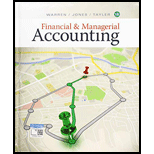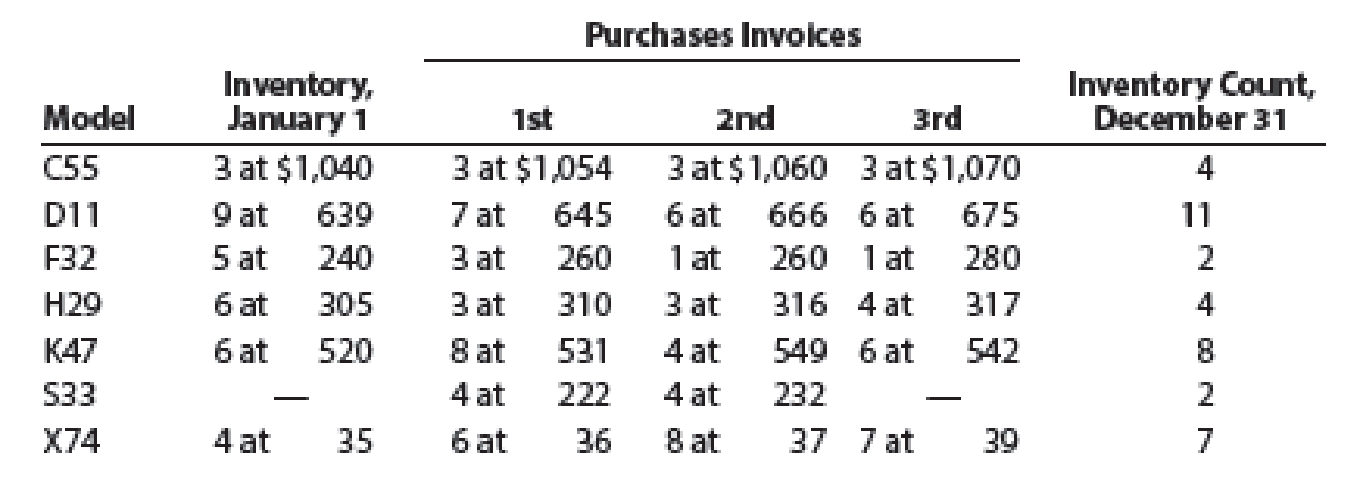
Concept explainers
Pappa’s Appliances uses the periodic inventory system. Details regarding the inventory of appliances at January 1, purchases invoices during the year, and the inventory count at December 31 are summarized as follows:

Instructions
- 1. Determine the cost of the inventory on December 31 by the first-in, first-out method. Present data in columnar form, using the following headings:

If the inventory of a particular model comprises one entire purchase plus a portion of another purchase acquired at a different unit cost, use a separate line for each purchase.
- 2. Determine the cost of the inventory on December 31 by the last-in, first-out method, following the procedures indicated in (1).
- 3. Determine the cost of the inventory on December 31 by the weighted average cost method, using the columnar headings indicated in (1).
- 4.
 Discuss which method (FIFO or LIFO) would be preferred for income tax purposes in periods of (a) rising prices and (b) declining prices.
Discuss which method (FIFO or LIFO) would be preferred for income tax purposes in periods of (a) rising prices and (b) declining prices.
(1)
Determine the value of inventory using first in first out method under periodic inventory system.
Explanation of Solution
Periodic Inventory System:
Periodic inventory system is a system, in which the inventory is updated in the accounting records on a periodic basis such as at the end of each month, quarter or year. In other words, it is an accounting method which is used to determine the amount of inventory at the end of each accounting period.
First-in-First-Out:
In First-in-First-Out method, the costs of the initially purchased items are considered as cost of goods sold, for the items which are sold first. The value of the ending inventory consists of the recent purchased items.
The tabular column showing inventory cost is presented as follows:
| Model | Quantity ($) | Unit cost ($) | Total cost ($) |
| C55 | 3 | 1,070 | 3,210 |
| 1 | 1,060 | 1,060 | |
| D11 | 6 | 675 | 4,050 |
| 5 | 666 | 3,330 | |
| F32 | 1 | 280 | 280 |
| 1 | 260 | 260 | |
| H29 | 4 | 317 | 1,268 |
| K47 | 6 | 542 | 3,252 |
| 2 | 549 | 1,098 | |
| S33 | 2 | 232 | 464 |
| X74 | 7 | 39 | 273 |
| Total | 18,545 |
Table (1)
Hence, the ending inventory under First in First out Method is $18,545.
(2)
Determine the value of inventory using last in first out method under periodic inventory system.
Explanation of Solution
Last-in-Last-Out:
In Last-in-First-Out method, the costs of last purchased items are considered as the cost of goods sold, for the items which are sold first. The value of the closing stock consists of the initial purchased items.
The tabular column showing inventory cost is presented as follows:
| Model | Quantity ($) | Unit cost ($) | Total cost ($) |
| C55 | 3 | 1,040 | 3,210 |
| 1 | 1,054 | 1,054 | |
| D11 | 9 | 639 | 5,751 |
| 2 | 645 | 1,290 | |
| F32 | 2 | 240 | 480 |
| H29 | 4 | 305 | 1,220 |
| K47 | 6 | 520 | 3,120 |
| 2 | 531 | 1,062 | |
| S33 | 2 | 222 | 444 |
| X74 | 4 | 35 | 140 |
| 3 | 36 | 108 | |
| Total | 17,789 |
Table (2)
Hence, the ending inventory under Last in First out Method is $17,789.
(3)
Determine the value of inventory using weighted average method under periodic inventory system.
Explanation of Solution
Weighted-average cost method:
Under Weighted average cost method, the company calculates a new average cost after every purchase is made. It is determined by dividing the cost of goods available for sale by the units on hand.
The tabular column showing inventory cost is presented as follows:
| Model | Quantity ($) | Unit cost ($) | Total cost ($) |
| C55 | 4 | 1,056 (1) | 4,224 |
| D11 | 11 | 654 (2) | 7,194 |
| F32 | 2 | 252 (3) | 504 |
| H29 | 4 | 311 (4) | 1,244 |
| K47 | 8 | 534 (5) | 4,272 |
| S33 | 2 | 227 (6) | 454 |
| X74 | 7 | 37 (7) | 259 |
| 18,151 |
Table (3)
Working note (1):
Computation of unit cost for Model C55:
Working note (2):
Computation of unit cost for Model D11:
Working note (3):
Computation of unit cost for Model F32:
Working note (4):
Computation of unit cost for Model H29:
Working note (5):
Computation of unit cost for Model K47:
Working note (6):
Computation of unit cost for Model S33:
Working note (7):
Computation of unit cost for Model X74:
Hence, the ending inventory under weighted average cost Method is $18,151.
4
(a)
Discuss the method that would be preferred for income tax purposes in the period of rising prices.
Explanation of Solution
During the period of rising prices, the last in first out method will result in lower cost of inventory, the cost of merchandise sold will be higher, and net income would be lower than other two methods. Therefore, the LIFO method would be preferred for the current year because it would effect in lower income tax.
Want to see more full solutions like this?
Chapter 6 Solutions
Financial And Managerial Accounting
- INVOLVE was incorporated as a not-for-profit organization on January 1, 2023. During the fiscal year ended December 31, 2023, the following transactions occurred. 1. A business donated rent-free office space to the organization that would normally rent for $35,600 a year. 2. A fund drive raised $188,000 in cash and $106,000 in pledges that will be paid next year. A state government grant of $156,000 was received for program operating costs related to public health education. 3. Salaries and fringe benefits paid during the year amounted to $209,160. At year-end, an additional $16,600 of salaries and fringe benefits were accrued. 4. A donor pledged $106,000 for construction of a new building, payable over five fiscal years, commencing in 2025. The discounted value of the pledge is expected to be $94,860. 5. Office equipment was purchased for $12,600. The useful life of the equipment is estimated to be five years. Office furniture with a fair value of $10,200 was donated by a local office…arrow_forwardFairfield Company's payroll costs for the most recent month are summarized here: Item Hourly labor unges Description 920 hours $27 per hour 190 hours for Job 101 340 hours for Job 102 Factory supervision Production engineer Factory Janitorial work Selling, general, and administrative salaries Total payroll costs Required: 390 hours for Job 103 Total Cost $ 5,130 9,180 10,530 $ 24,840 4,350 7,100 1,200 8,800 $ 46,298 1. & 2. Prepare the journal entries for payroll and to apply manufacturing overhead to production. The company applies manufacturing overhead to products at a predetermined rate of $54 per direct labor hour Note: If no entry is required for a transaction/event, select "No Journal Entry Required" in the first account field. View transaction list Journal entry worksheet A B Record Fairfield Company's payroll costs to be paid at a later date. Note Enter debits before credits. S.No Date 1 Account Title Debit Creditarrow_forwardNo wrong answerarrow_forward
- L.L. Bean operates two factories that produce its popular Bean boots (also known as "duck boots") in its home state of Maine. Since L.L. Bean prides itself on manufacturing its boots in Maine and not outsourcing, backorders for its boots can be high. In 2014, L.L. Bean sold about 450,000 pairs of the boots. At one point during 2014, it had a backorder level of about 100,000 pairs of boots. L.L. Bean can manufacture about 2,200 pairs of its duck boots each day with its factories running 24/7. In 2015, L.L. Bean expects to sell more than 500,000 pairs of its duck boots. As of late November 2015, the backorder quantity for Bean Boots was estimated to be about 50,000 pairs. Question: Now assume that 5% of the L.L. Bean boots are returned by customers for various reasons. L. Bean has a 100% refund policy for returns, no matter what the reason. What would the journal entry be to accrue L.L. Bean's sales returns for this one pair of boots?arrow_forwardThe following data were taken from the records of Splish Brothers Company for the fiscal year ended June 30, 2025. Raw Materials Inventory 7/1/24 $58,100 Accounts Receivable $28,000 Raw Materials Inventory 6/30/25 46,600 Factory Insurance 4,800 Finished Goods Inventory 7/1/24 Finished Goods Inventory 6/30/25 99,700 Factory Machinery Depreciation 17,100 21,900 Factory Utilities 29,400 Work in Process Inventory 7/1/24 21,200 Office Utilities Expense 9,350 Work in Process Inventory 6/30/25 29,400 Sales Revenue 560,500 Direct Labor 147,550 Sales Discounts 4,700 Indirect Labor 25,360 Factory Manager's Salary 63,400 Factory Property Taxes 9,910 Factory Repairs 2,500 Raw Materials Purchases 97,300 Cash 39,200 SPLISH BROTHERS COMPANY Income Statement (Partial) $arrow_forwardNo AIarrow_forward
- L.L. Bean operates two factories that produce its popular Bean boots (also known as "duck boots") in its home state of Maine. Since L.L. Bean prides itself on manufacturing its boots in Maine and not outsourcing, backorders for its boots can be high. In 2014, L.L. Bean sold about 450,000 pairs of the boots. At one point during 2014, it had a backorder level of about 100,000 pairs of boots. L.L. Bean can manufacture about 2,200 pairs of its duck boots each day with its factories running 24/7.In 2015, L.L. Bean expects to sell more than 500,000 pairs of its duck boots. As of late November 2015, the backorder quantity for Bean Boots was estimated to be about 50,000 pairs. Question: Assume that a pair of 8" Bean Boots are ordered on December 3, 2015. The order price is $109. The sales tax rate in the state in which the boots are order is 7%. L.L. Bean ships the boots on January 29, 2016. Assume same-day shipping for the sake of simplicity. On what day would L.L. Bean recognize the…arrow_forwardFinancial accounting questionarrow_forward2 Questionarrow_forward
 Financial And Managerial AccountingAccountingISBN:9781337902663Author:WARREN, Carl S.Publisher:Cengage Learning,
Financial And Managerial AccountingAccountingISBN:9781337902663Author:WARREN, Carl S.Publisher:Cengage Learning, Financial AccountingAccountingISBN:9781337272124Author:Carl Warren, James M. Reeve, Jonathan DuchacPublisher:Cengage Learning
Financial AccountingAccountingISBN:9781337272124Author:Carl Warren, James M. Reeve, Jonathan DuchacPublisher:Cengage Learning Financial AccountingAccountingISBN:9781305088436Author:Carl Warren, Jim Reeve, Jonathan DuchacPublisher:Cengage Learning
Financial AccountingAccountingISBN:9781305088436Author:Carl Warren, Jim Reeve, Jonathan DuchacPublisher:Cengage Learning Survey of Accounting (Accounting I)AccountingISBN:9781305961883Author:Carl WarrenPublisher:Cengage Learning
Survey of Accounting (Accounting I)AccountingISBN:9781305961883Author:Carl WarrenPublisher:Cengage Learning Intermediate Accounting: Reporting And AnalysisAccountingISBN:9781337788281Author:James M. Wahlen, Jefferson P. Jones, Donald PagachPublisher:Cengage LearningPrinciples of Accounting Volume 1AccountingISBN:9781947172685Author:OpenStaxPublisher:OpenStax College
Intermediate Accounting: Reporting And AnalysisAccountingISBN:9781337788281Author:James M. Wahlen, Jefferson P. Jones, Donald PagachPublisher:Cengage LearningPrinciples of Accounting Volume 1AccountingISBN:9781947172685Author:OpenStaxPublisher:OpenStax College





